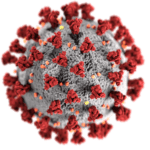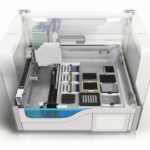Design engineers involved in motion control and system components — check it out: The 2020 Design World Motion Trends issue has gone to press, and the digital version is now live at issuu.com in case you haven’t received a hard copy. By the way, if you’d like to subscribe to Design World, the signup is at this subscription link on designworldonline.com.
Our coverage of automation shifted somewhat to accommodate editorial on designs that will help fight the COVID-19 pandemic. Here are links to those and the rest of our regularly scheduled stories …
Motion-control systems help automate COVID-19 testing
 This article details how automated biochemical analyzers vastly accelerate the testing of patient samples in laboratories, which has become critical now that the COVID-19 pandemic has spread across the globe.
This article details how automated biochemical analyzers vastly accelerate the testing of patient samples in laboratories, which has become critical now that the COVID-19 pandemic has spread across the globe.
Read more about COVID-19 testing approaches (existing and on the horizon) from our sister site: Test and Measurement Tips: How the health care system tests you for the COVID-19 virus.
Also read: Can you really make a respiratory ventilator in a car factory?… another COVID-19 editorial from Lee Teschler
Advanced automation with motor-based motion systems will help hasten diagnoses.
Trends in gears and gearmotors for eMobility • washdown • customization
In this article, we hear from maxon’s own Christian Fritz on eMobility; Stock Drive Products/Sterling Instrument (SDP/SI) on miniaturization; Robert Shouppe of CGI Motion on customization; and Terry Auchstetterat Bodine Electric along with John Mason at NORD Gear Corp. for their input on the trend in gearmotors to more integration.
Motors get more connected — and more efficient

2020 is seeing new trends in the application of stepper motors as well as permanent-magnet synchronous motors (PMSMs), brushless motors, and direct-drive motors including torque motors. Perhaps one of the most dramatic trends is increased use of PMSMs or synchronous ac motors.
They began seeing more use in the early 2000s, and now such motors (sometimes called brushless ac motors, permanent-magnet ac motors, or PMACs) have become fairly common in a range of applications … including those for hoists and cranes, conveyors, printing, packaging, and vehicle hub drives such as those in AGVs.
Automation putting faster in the fast-food industry
To the relief of those who are indecisive at the drive through, McDonald’s Corp. will soon be ramping up its use of voice-activated order taking. That’s according to a Wall Street Journal report last year — which also details how designs coming to the restaurant also include automatic systems to operate the deep fryers for its chicken patties and nuggets, fish filets, and French fries …

XY2Z-theta motion system improves wafer inspection for the semiconductor industry
One new linear-motion system from PM called the Vega motion stage combines several design features to optimize backend wafer inspection applications.
![]() Over a stroke of more than three hundred millimeters, mechanical accuracy in the X and Y directions must exceed 1 µm even to 2 g and speeds to 2 m/sec. Vibrations in that plane must remain below 25 nm. Vibrations in the Z axis — used to get the wafer into the optics’ focal point — must stay below 10 nm. Complicating matters is that the wafer must shoot back and forth at lightning speed … a motion that generates copious heat in the process. But such motion is essential to maintaining the high throughput required for effective chip production.
Over a stroke of more than three hundred millimeters, mechanical accuracy in the X and Y directions must exceed 1 µm even to 2 g and speeds to 2 m/sec. Vibrations in that plane must remain below 25 nm. Vibrations in the Z axis — used to get the wafer into the optics’ focal point — must stay below 10 nm. Complicating matters is that the wafer must shoot back and forth at lightning speed … a motion that generates copious heat in the process. But such motion is essential to maintaining the high throughput required for effective chip production.
Electric actuators help reconfigure rooms in futuristic flexible residential construction
One team from Virginia Tech University recently designed a solution to make transformable home living spaces. Now their smart house prototype has rooms that can reconfigure on command by touch, voice, gesture or smartphone. Their design includes electric-motor-driven linear motion from Thomson Industries to move room-sized load-carrying walls smoothly and quietly.
Linear shaft motors see increased force capabilities thanks to advances in magnets
 Today most linear-motion designs execute their strokes with actuators based on stepper motors or brushless dc (BLDC) servo motors. Such designs have an inherent complexity due to the fact that the motors and its gearing and encoder must essentially hang off the machine design and out of the needed motion space.
Today most linear-motion designs execute their strokes with actuators based on stepper motors or brushless dc (BLDC) servo motors. Such designs have an inherent complexity due to the fact that the motors and its gearing and encoder must essentially hang off the machine design and out of the needed motion space.
One fast-growing trend is migration towards linear shaft motors — a more compact solution that only requires space for an encoder and linear bearing inside the motion space. That’s according to Paul Denman, applications engineer and business development at Nippon Pulse America, who provided the insight for this article.
Linear guides, power transmission, actuators see unexpected applications
Our 2020 survey of the industry indicates an unabated trend towards more automation of previously static or manually tended systems. Key to these new offerings is installation simplicity for OEMs and end users of linear components for linear axes … as well as positioning stages and Cartesian robots.
In fact, Cartesian robots (also called linear robots) increasingly serve as turnkey solutions where tasks were previously done manually. That’s in part because (where suitable) linear-based solutions offer simplicity and precision at a price point that’s unrivaled by other solutions. So linear-motion adherents want these multi-axis arrangements to come to mind when laypeople and engineers alike discuss robotics …

CP Aeronautics — a new vertically integrated UAS manufacturer
This new company uses an array of precision motors in its integrated turnkey unmanned aerial systems (UAS) platforms as well as designs to handle various payloads, data links, ground control stations, and communications for defense and civil applications.
Dampers improve doors on high-end tractor cabs

For their newest orchard tractor cabs, Key Dollar Cab wanted a very specific feature — something unique to their offering to serve end customers with a durable and refined element. The Key Dollar Cab engineers wanted the tractor doors to exhibit smooth and controlled motion upon opening. The requirement could not be satisfied by a standard gas spring or shock; the engineers needed a custom damper for their application.
Top bearing trends: IoT, new materials, and innovation lubrication modes
The widespread adoption of condition monitoring technologies such as vibration analysis is a testament to the early adopters who pioneered their use within the industry. These technologies transformed the way we think about maintenance by providing users the ability to determine the health of an asset without interfering with its operation.
The industrial internet of things (IIoT) coupled with declining sensor costs has further accelerated the use of these technologies and enabled remote monitoring of real-time data, automated analysis, and instantaneous alerts.
“One challenge that we see frequently is customers becoming disenfranchised with the technology because it wasn’t applied correctly to the asset and, as a result, does not provide advanced warning of faults or degradation. One-size solutions do not fit every application for the end customer,” says Dan Phillips, director of technology monitoring and diagnostics for Regal Beloit …
Why eLearning About VFDs (and other technical topics) just may fit the bill

With the current state of the internet and the interconnectivity of devices and equipment, it is in the best interest of any company that wants to optimize the productivity of their associates tasked with technical tasks to take a look at the eLearning available. eLearning offers a wonderful ROI due to its low cost, ease of access, skill based objectives, and ability to customize to each viewer. That’s according to Paul Avery, product training engineer at Yaskawa America’s Drives and Motion Division.
“Like all things in modern life, the internet has changed the game when it comes to training people on technical topics. Admit it: The last time you had to repair something around the house you first did a quick search of YouTube to see if there was a video that showed step-by-step how to fix your exact model. The same thinking can be applied to industrial and commercial devices that are just too complex to be intuitive, ” says Avery …
Sensors on the front lines of industrial networking

As companies continue to look for ways to improve their processes, operate more efficiently, increase their productivity and lower expenses, they are investing in the latest sensor and networking technologies. Demand is rising in a range of industries including robotics, factory automation, off-highway applications as well as farming and fast food, among others.
Trends: Brakes and clutches take miniaturization to new extremes
Clutches and brakes as well as torque limiters continue to evolve as the requirements for new applications for holding, stopping, and indexing continue to multiply. The ongoing trend for these technologies towards application-specific variations continues unabated — especially as several industries have exceeded capabilities of legacy stock parts.
 “Mach III has experienced a strong increase in application inquiries for miniature clutches, brakes, and torque limiters. In 2019, we had 14 new projects requiring a miniature clutch, brake, or torque limiter — more than in the prior three years combined,” explains president of Mach III Clutch Inc. Lesli Riehemann.
“Mach III has experienced a strong increase in application inquiries for miniature clutches, brakes, and torque limiters. In 2019, we had 14 new projects requiring a miniature clutch, brake, or torque limiter — more than in the prior three years combined,” explains president of Mach III Clutch Inc. Lesli Riehemann.
New tools and services aid ball screw selection and design
Ball screw performance continues to improve, thanks to advancements in manufacturing methods and materials. Newer generations of ball screws have higher load capacities, which means they’re increasingly being used for applications with higher loads as well as more challenging environmental conditions. Hence, the rise in ball-screw-driven actuators replacing traditional fluid power actuation methods in some high-force applications.
Newer ball screw designs can also better resist harsh conditions such as extreme temperatures, high particulate levels, exposure to chemicals and high-pressure washdown environments, as well as shock and vibration …

New applications drive encoder design trends
Encoders are central to motion control applications. They can provide position, speed, and direction feedback to a controller or drive to increase the accuracy and reliability of a drive system. As technology evolves, so too do encoders, incorporating the latest advancements in communications and networking and offering engineers tools to solve challenges they face across a diverse array of motion control applications …
Drive trends propel robotics and IoT applications
The overall trend in drives is for more powerful, capable, and feature-rich products to handle the challenges of automation and control over a range of industries and applications. We asked some top drive manufacturers what they’re seeing and here’s what they told us.
Mike Wolfe, business development manager at Control Techniques: In robotics, we’ve seen a significant increase of activity in the automated guided vehicle (AGV) segment of robotics. Precision motion, fieldbus control options and distributed on-board motion control are some of the key needs in this market space. In factory automation, we’ve seen continued strong demand in general factory automation for drives and motors above 150 hp …
New applications a major trend for shocks and vibration mitigation in 2020

Automated machinery and manual designs alike must exhibit minimal vibration and should gently and precisely slow and moving masses on (or engaged with) the design. Our 2020 Design World Trends survey of industry experts indicates an uptick in new applications for shocks, damping, gas springs, and kinematic holding that were previously done manually or run without any shock and vibration protection at all. These designs see the most performance improvements when vibrations are isolated or damped.
In other instances, incorporation of sensing capabilities has (just as with couplings) leveraged the strategic placement of shock absorbers to gain IoT (Industry 4.0) functionalities. Just consider the input of Brad Griffin, product line manager at ITT Enidine, for more on this …







Leave a Reply
You must be logged in to post a comment.